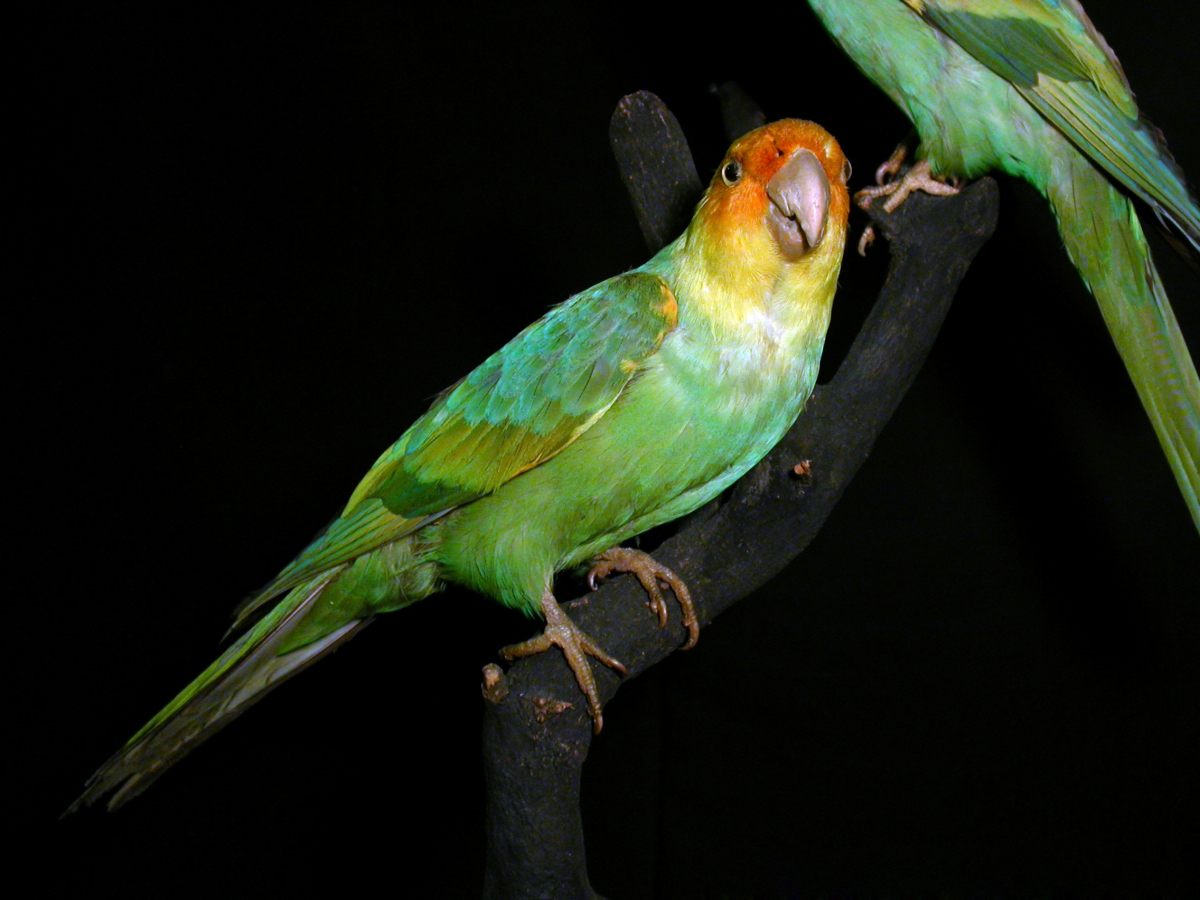Today is National Sticky Bun Day. I suggest we also designate it Global Last Resort Day. Then it would coincide with the centennial of the death of Incas, the last Carolina parakeet in the world, who died on February 21st, 1918, at the Cincinnati Zoo.
The Carolina parakeet was a colorful and gregarious species. Its green, yellow, and orange plumage lit up the skies of the eastern third of North America for eons. It was seen during blizzards in upstate New York. It flocked above Florida swamps. It roosted in hollow sycamores along rivers in Kansas and Missouri. The birds fed on seeds, fruits, and nuts and were plentiful until European settlement. The species succumbed to various perils. One biologist has argued that the hollow trees the birds used for nests and winter roosts were invaded by European honeybees that pioneers brought with them, and that moved ahead of actual settlement. It’s undisputed that the Carolina parakeet was killed for the feather trade—whole dead birds would sometimes adorn women’s hats—and for being an agricultural pest.
The birds were easy to kill, in part because they would whirl and cry in distress over injured and dead kin. Forests were cleared, and the population of the Carolina parakeet began to fragment, succumbing more easily to disease, extreme weather, and predation. A social species such as the Carolina parakeet likely needed a certain population level in flocks to trigger successful breeding. Whatever the combination of factors, the bird was gone from the wild by the early decades of the 20th century, if not far sooner.
It is too much to have expected Americans of the time to preserve these birds in the wild—such an ethic was not quite yet in the air. But they bred in captivity. Some of the most heartbreaking documents of the species’ life and death are photos of captive, baby Carolina parakeets. They look like helpless little dinosaurs. Captive breeding in the early 20th century was not a collaborative affair. Institutions and private individuals did not come together to exchange birds and cooperate in making such breeding efforts organized. Had they, the Carolina parakeet might well still be with us.
HOW A MASS EXTINCTION EVENT CAUSED A BOOM IN MOST OF THE FROG SPECIES ALIVE TODAY: New research suggests that the mass extinction event that occurred 66 million years ago—when the dinosaurs were wiped out by an asteroid that collided with Earth—spurred something of an explosion of new frog species.
Instead, Incas died a year after his mate, Lady Jane, and some four years after the death of the last known passenger pigeon, Martha. Incas actually died in the same stone aviary as the better-known Martha.
A last resort, per the Oxford English Dictionary, is “a final course of action, used only when all else has failed.” Organized, cooperative captive breeding would have been the last resort to save the astonishingly beautiful and now largely forgotten Carolina Parakeet.
As I write this, I am thinking of these birds and of Cape Town’s impending Day Zero, when water will be cut off to households, forcing hundreds of thousands of residents to trek to water-filling stations to collect their strict rations. I’m thinking about above-normal heat in Tucson, Arizona, where I live. I’m thinking about research that tells us we face civilization-ending levels of climate change by century’s end if we do not get to a zero-carbon economy soon, thus helping to reduce the effects of global warming that are inevitable because of carbon that’s already in the atmosphere. The parakeets, like all species brought to extinction at human hands, represent one more blow to the richness of the material world that we all need in order to survive. They were pretty, yes, but more than that, they were alive, a functioning part of one corner of the biosphere. Their loss has not undone North America. But as extinctions mount, that excuse applied to so many dead species begins to look scary.
As individuals, we are encouraged by our loved ones, friends, colleagues, even enemies and strangers, to learn from our mistakes. Like the Carolina parakeet, we are a social species. We are prodded by face-to-face interactions. Some of us learn faster than others—I can be particularly slow—but nonetheless, as individuals, we can learn, cultivate compassion, make amends, plan for a better future. Still, the capacity to learn and change diminishes as the social scale grows. Multiply our slowness to learn as individuals with, well, with all of us and throw in highly complex questions of politics and policy—and you have the present. Inertia.

(Photo: Wikimedia Commons)
Injecting calcite particles into the stratosphere to create a layer that would reflect sunlight and thus cool the planet? Would we use that as an excuse to continue using fossil fuels? That would replace one inertia with another; that is, we’d temporarily “solve” the problem of a heating planet but do so by likely a longer locking-in of fossil-fuel dependency.
To save corals, will we act on recent findings that show if we flip a genetic switch, we can make some species resistant to bleaching? Is genetically engineering wild plants and animals to cope with changing conditions something we would do? A last resort?
I think we may have hit the point where bold—even dangerous—approaches to all kinds of wicked problems are becoming our only options.
From global hunger to rising energy demands, from gender and social inequity to generations crippled with horrid schooling, what are our last resorts? If we want to survive for a bit longer—and help some other parts of nature too—we had best stop deluding ourselves. We are basically out of time.
It’s Global Last Resort Day. Our mascot is a dead Carolina parakeet named Incas.





